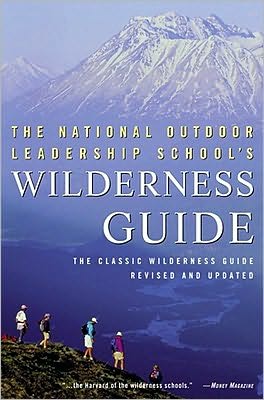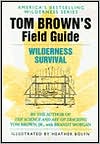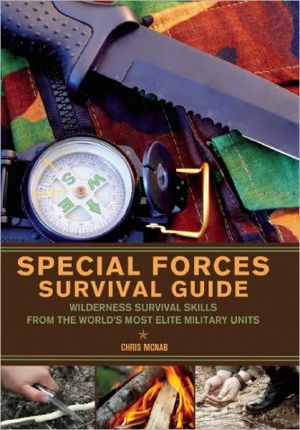The National Outdoor Leadership School's Wilderness Guide: The Classic Wilderness Guide
The classic backpacker's handbook — revised and updated — providing expert guidelines for anyone who loves the outdoors.\ The Wilderness Guide brings the savvy of the world's most famous and respected outdoor organization to everyone — from the 16 million backpacking Americans to the more than 265 million people, tenderfeet and trail-hardened hikers, who visit our national parks annually. It covers:\ \ Selecting equipment — including discussions of the advantages and disadvantages of products...
Search in google:
The classic backpacker's handbook -- revised and updated -- providing expert guidelines for anyone who loves the outdoors. The Wilderness Guide brings the savvy of the world's most famous and respected outdoor organization to everyone -- from the 16 million backpacking Americans to the more than 265 million people, tenderfeet and trail-hardened hikers, who visit our national parks annually. It covers: Selecting equipment -- including discussions of the advantages and disadvantages of products such as the internal frame pack, lighter-weight boots, and freestanding tents The latest "leave no trace" camping techniques Traveling safely and sensibly -- including vital information on maps, compasses, and tips on crossing difficult terrain Backcountry cooking, with tips on building fires and tricks for making gourmet meals Search-and-rescue techniques, including how to organize a self-sufficient search group and when to call in professional rescue teams Illustrated throughout with instructional drawings and photos and featuring lists of equipment, the Wilderness Guide is a must-have for anyone planning to explore the great outdoors. High Country News This starting-from-scratch revision of The National Outdoor Leadership School's Wilderness Guide will tell you what to wear, how to navigate, and how to get across streams and scree fields in the backcountry. It will give you tips on whether to evacuate an injured person by helicopter, how to treat blisters, and how to look for lost members of your group. This is all useful and well written. But the book's major strength is its many discussions of the psychology and etiquette of being in the forests, deserts or high country. Mark Harvey shares many stories and anecdotes to drive home his points. The material on leading and being led is especially well done.
From Chapter 2\ Expedition Planning\ When the directors of the NOLS Patagonia branch plan a seventy-day semester, their decisions involve kayaks, horses, planes, boats, trucks, thousands of pounds of food, high expectations, unknown terrain, glaciers, devilish Patagonia weather, and even a tactfully written letter to the Chilean navy. The logistics for these trips are formidable, but the principles for planning them are the same principles you or I can use to plan a three-day trip to the Smoky Mountains.\ The celebrated adventurer Bill Tilman once said, "Any worthwhile expedition can be planned on the back of an envelope." Expedition planning needn't be overly complex or metaphysical. Part of the fun of the outdoors comes in spontaneous trips when you call a few friends, throw some things in a pack, and head for the hills. But paradoxically, the people most successful at "spontaneous" trips are those with the practical experience to bring the right gear, some maps, and enough fuel, and the leadership experience to choose the right people for the venture — even if they leave for the wilds on the spur of the moment.\ In the summer of 1998, Neal Beidleman, a guide credited with saving many lives on the ill-fated 1996 Mount Everest expedition, gave a lecture at the International Design Conference in Aspen, Colorado, about "designing" an expedition. The gist of Beidleman's lecture was that any design — whether for a product, a building, or an expedition — depends on leadership, common group objectives, good equipment, teamwork, and a balance between the flexibility to improvise and a rigid plan to fall back on in the event of a crisis. Beidleman went on to say that the weaknesses in the design of the Everest expedition were exposed by the harsh conditions. What struck me most about Beidleman's lecture was his portrayal of an expedition as a living, breathing entity wherein every part of the design — the equipment, the people, the leadership, and the objectives — all act on each other to form either a successful trip or a failed trip.\ Some people seem to have a knack for planning good expeditions. Every year, fellow NOLS instructor and friend Dave Glenn organizes an odd assortment of rednecks, government land managers, and green tree huggers, throws them all together on three or four rubber rafts, floats them through a rough river, and has them finish the adventure making deep political concessions to each other just from the joy of completing a well-designed trip. Dave succeeds at making these impossibly unlikely combinations of people work partly from having a knack with people but also from years of experience, mastery of the planning fundamentals, and surely the experiential benefit of some failures.\ In this chapter you will learn a simple outline of variables to consider in designing your own trip. Every trip in the outback involves five main elements: team and leadership; expedition goals; route planning; contingency plans; and ration planning. All these elements, while considered separately for the sake of this chapter, are interconnected and interdependent. The people you bring on your trip will determine the expedition goals; good rations will help keep your group healthy enough to achieve its goals; a well-planned route will help morale. The relationships between these five elements of your plan are endless but the point here is simple: The well-designed trip comes of good planning. Every trip is different, but this outline will help you plan every time.\ • Team and leadership\ • Expedition goals\ • Route planning\ • Contingency plans\ • Ration planning\ Team and Leadership\ IT ALL BEGINS WITH YOU\ Before you go, make an honest appraisal of your abilities and experience. This is not the time to pad your resume but a time to evaluate your skills, physical condition, and background with some modesty so you will not choose a trip beyond your competence.\ Perhaps you are a raw beginner with little or no outdoor experience but a strong athlete and tough as leather. Maybe you have Woody Allen's physique and his affinity for the outdoors as well. Perhaps you have camped a dozen times in the last two years but always with an organized program. Maybe you have a technical background in rock climbing but have never traveled in the Arizona desert, where you are planning to go for your next adventure.\ Everyone has certain strengths, be they athletic abilities, mental resilience, or extraordinary patience; and everyone has certain liabilities — fear of heights or poor orientation, for instance. Every year, inexperienced hikers get injured or lost or killed because they attempt trips beyond their abilities. This is not meant to scare you but to raise your awareness. When planning your trip ask yourself these questions:\ • What is the sum total and nature of my outdoor experience?\ • Would I be able to handle an emergency such as a seriously injured or lost party member, or a situation in which I myself was injured?\ • Do I have the physical conditioning and psychological mindset to complete this trip?\ CHOOSING YOUR TEAMMATES\ The most important decision you make in planning your trip is who gets to go with you. Your teammates are your best resource in the day-to-day routine and in an emergency. Having good people along — people you enjoy and trust — is the foundation of a good expedition.\ After taking stock of your own abilities, consider the abilities and personalities of your teammates. You want a group with matching abilities, compatible personalities, and good judgment. It's certainly fine to bring people of varying skills, but those going should know in advance and agree to be flexible enough to accommodate weaker or less experienced teammates or, when traveling with those who have superior skills, be in a learning role. If you invite a friend with a penchant for long grueling days on the trail, along with a friend who fancies lazy reverie under a banyan tree, you may be asking for a quarrel. Invite a couple intent on consummating their nuptials at every spare moment, and you'll chafe the lone ascetic in the group. Members invited on your trip should know what the pace and style of the trip will be. Perhaps you want to complete a challenging route and do dozens of peak ascents. Perhaps you all just want to get out, relax, fish, and cook lots of good meals. The important thing is that everyone in the group knows what to expect.\ If possible, sample your friends on a day hike before you invite them to join you on a long expedition. Even a day of hiking together will give you some idea of their fitness, their attitudes, their moods, and their quirks.\ Here are some questions to ask yourself when choosing your teammates:\ • Do they have common sense and good judgment? Would you trust the prospective teammate to get you out of the backcountry if you became incapacitated?\ • Are they of your ability? Will you be comfortable traveling with someone who is much more conservative in judgment than you are, or, conversely with someone who is much more aggressive?\ • Will you enjoy each other's company?\ GROUP SIZE\ Small groups are mobile and involve simple logistics. With a small group you don't have to convene an assembly for every decision about where to hike or what meals to bring. When I go on trips where I want to cover a lot of terrain or climb peaks, I much prefer to travel with a small team. There is less to go wrong and fewer opinions to sway.\ Four is often cited at NOLS as a minimum number of people for an expedition. In the event of an injury, one person can stay with the injured party while two people go for help. While traveling in a group of four may be safer than, say, traveling with just one buddy, you should not always feel obligated to travel with three other people. However, you must consider that a smaller group's advantages mean diminished resources (people) in the event of an emergency.\ Large groups are raucous good fun but require more formal organization, logistics, and leadership. I love to go on a river trip with four boats and 20 people given one condition: Someone else organizes everything. If the small group can float like a butterfly and sting like a bee, the large group moves like a well-meaning jellyfish.\ In a large group you have more personalities, which adds to the fun, but can also slow down the whole decision-making process. Ever try to pick a restaurant with 15 relatives hovering about? With a large group, you have more chances of someone getting injured, simply because of the statistics, but also more resources and options available.\ Large groups obviously require more room to camp, and can have a tougher impact on the environment just by sheer volume. If you travel in a large group, you have to work harder to minimize your impact on the environment.\ TRAVELING SOLO\ Traveling solo in the backcountry is at once liberating, free, and lonely. The solitude may be just what your soul needs. Alone you will likely see more wildlife, have more flexibility in everything from choosing a campsite to cooking a meal, and perhaps find focus and clarity. But those new to solo travel need to be prepared for the sense of isolation in a vast space. If you travel alone you are in a sense climbing without a rope, and as such, you have less room for error. When traveling solo, you need to be more conservative in nearly everything you do. The river you might cross with a group of friends on hand may be too risky as a lone traveler. An off-trail shortcut you'd take with even one more person might not be wise when alone.\ If you do decide to travel solo, learn the art in increments. Start with a single night or two and work your way up to traversing the Pacific Crest Trail. Since you will have no one in the immediate area to watch over you unless there are nearby travelers, you should leave an itinerary with a trusted friend or relative. The itinerary should include the following:\ • A detailed route plan.\ • Where your car will be parked if you drive to the roadhead. Usually the first thing a search and rescue team will check is whether your car is still parked at the roadhead.\ • A generous but well-defined overdue date. If you plan to go for three days, you might tell your contact person you plan to be back on day three but not to send the cavalry until day four or five. The "freak time" should be clearly defined so there is no ambiguity and your friend doesn't call for help either too early or too late.\ • Specific medical problems you have (e.g., diabetes, heart problems, epilepsy, etc.).\ • A list of the gear, food, and fuel you are carrying. It is useful for rescue teams to know whether you have a light summer sleeping bag or a heavy bag, a high-quality tent or a sheet of plastic, and food enough for two days or four.\ • Whom to call if you do not arrive on time. Typically this would be the local sheriff or search and rescue team.\ • A description of what you plan to do in an emergency situation (e.g., use a cell phone, a radio, a signal mirror, or a signal fire).\ LEADERSHIP\ Chapter 7 discusses leadership in depth, but the matter of leadership and how decisions will be made once out on the trail should be part of your expedition planning. Many people who go out on a trip don't assign formal leadership roles. They make decisions through informal discussions and if there is a leader, he or she arrives at the position through some sort of organic process, not by a conscious and spoken group choice. That style may work well for teams that have traveled together before and have proven to work well together as a team. But when you travel in a large group or when your trip becomes more involved — remote, big mountain expeditions, for instance — you are better off designating a leader. It is arguably better to designate a leader even for trips of small consequence. The leader needn't make all the group's decisions in an autocratic way, but in a crunch, such as a medical emergency, having an official leader could mean faster action. The leader's role may include deciding whether or not to complete a route, planning an evacuation, moderating disputes, and boosting morale. The leader does not necessarily have to be the most experienced in the group, but he or she should be respected by all the members and have excellent judgment.\ It may be a little awkward, but if you discuss how day-to-day decisions are going to be made before you leave for the wilds, you will likely have a more successful trip. On all but the most fortunate expeditions, there comes a time when two or more group members don't agree on a matter large or small. If you agree in advance that the person leading that day will resolve the conflict or, on the other hand, that the decision will be made through consensus, you will save yourself the headache of coming up with an ad hoc plan out on the trail.\ A trip with every minute and every decision mapped out in advance would be too rigid and would feel like a forced march; some flexibility is necessary to adjust to the mood, health, and desires of the group members. But a leader and a plan should be chosen in advance to deal with the less forgiving circumstances.\ Five Common Mistakes People Make in Planning and Completing an Expedition\ • Not checking the crucial equipment such as the tent, stove, pack, and headlamp.\ • Underestimating the time and effort it will take to hike the distances shown on the map.\ • Planning to do too much on one trip and being overburdened by gear.\ • Concentrating so hard on completing a route that they forget to enjoy the views, smells, and sounds along the way.\ • Rushing out of the backcountry the last day and risking injury or separation from the group.\ COMMITMENT TO THE TRIP AND THE DIVISION OF LABOR\ It is a joy to travel with committed people. Such types troubleshoot sputtering stoves, make coffee on the miserable mornings, and catch meaty trout. Alas, those not committed spend lots of time in the tent (and take up lots of space as well), show pouty faces when the trail gets steep, and have little nice to say about someone's cooking. If you are going to commit good money and dear time to an expedition, better to know your companions feel the same sense of commitment. My friend Phil Powers, a NOLS instructor and highly accomplished mountaineer, suggests assigning planning tasks prior to leaving as a way to test commitment in the group. If, for example, you are traveling to the mountains for four days, have one member organize maps, another rations, and another transportation. If the person responsible for maps doesn't lift a finger as the departure date nears, ask him directly if he wants to go on the trip. Here are a few ways you may want to divide the tasks:\ • Ration planning: This person organizes and buys all the food. He or she should poll the other members on likes, dislikes, and allergies. This is a big job so it might take two people.\ • Maps, routes, and regulations: This person buys all the maps, researches regulations, and plans the route. As she plans, she can stay in contact with the rest of the group to pose options and solicit ideas.\ • Transportation: If your trip is simple — a two-day backpack in the backyard wilderness — this job may not be necessary. But if you do something exotic, say a trek in Peru, the transportation planning may take phone calls, foreign language skills, trips to the travel agent, and other intricate and time-consuming tasks.\ • Equipment planning and revision: This job entails the organization and revision of major group gear including the tent, stove, kitchen utensils, and first aid kit.\ SHARING COSTS\ Camping needn't be expensive but there are always costs — gas, food, maps, gear, etc. Find an equitable way to share the costs. If your buddy drives his rig, you pay for the gas. If your buddy brings his new tent, stove, and fishing gear, you spring for the maps. Keep it simple and agree upon it in advance.\ PHYSICAL CONDITIONING\ Hiking long miles with a heavy pack is strenuous. Climbing the hills takes strong legs, and balancing the pack weight over tricky stretches on the trail takes a strong back. The men and women who spend their waking hours teaching outdoor education or tackling high mountains fairly ripple with muscle and sinew, the author notwithstanding. All things being equal, the stronger you come into your trip, the more fun you'll have, the more you'll achieve, and the safer you'll be.\ A detailed plan is beyond the scope of this book, but the basics are worth mentioning. You don't have to train with the intensity of a marathoner before your trip but try to train for a few weeks prior to leaving. Your regimen should include three components: flexibility training, resistance training, and cardiovascular training.\ Developing flexibility before you go will reduce the chances of injury and will add to your agility. Find three or four stretches for the legs, and three or four for the trunk and arms. You can stretch just about anywhere — at the gym, in front of the TV, or at your desk. Out on the trail you may want to do a few stretches every morning as well, especially if you wake up sore and tight.\ Resistance training builds muscle mass, which will give you more power and help prevent injuries. You want resistance training that strengthens the entire body. You can do resistance training with weight machines or using your own body weight. Double knee bends (not beyond 90 degrees, please), one-legged knee bends, push-ups, sit-ups, chin-ups, trunk lifts, and weight lifting are all good forms of resistance training.\ There are many ways to build your cardiovascular level depending on where you live, your preferences, and how much free time you have. The most obvious and perhaps most logical activity to train for hiking trips is, well, hiking. If you live in a big city, this training may be impossible, but if you have access to the mountains on weekends or during the week, simply get out there and hike the most varied terrain you can find. Walking uphill will build leg strength on top of the cardiovascular conditioning. Walking downhill develops balance and leg strength as well. If you're going to be carrying a heavy pack on your actual trip, you may as well carry a pack in your training. If you are out of shape, start very light — say with ten pounds — and then add five pounds per week until you reach the approximate weight you plan to carry on your trip. Bicycling, running, and swimming are other good forms of exercise for developing your heart and lungs.\ Copyright © 1999 by The National Outdoor Leadership School
Acknowledgments15Foreword17Ch. 1Why We Go21Ch. 2Expedition Planning32Ch. 3Equipment Primer63Ch. 4How to Dress for the Backcountry96Ch. 5Camping Technique107Ch. 6Travel Technique134Ch. 7Leadership and Expedition Behavior165Ch. 8Maps and Compasses178Ch. 9Emergency Procedures203Ch. 10Weather215Ch. 11Cooking in the Backcountry228Ch. 12Our Responsibility to the Land243Equipment List251Suggested Reading255Index257
\ High Country NewsThis starting-from-scratch revision of The National Outdoor Leadership School's Wilderness Guide will tell you what to wear, how to navigate, and how to get across streams and scree fields in the backcountry. It will give you tips on whether to evacuate an injured person by helicopter, how to treat blisters, and how to look for lost members of your group. This is all useful and well written. But the book's major strength is its many discussions of the psychology and etiquette of being in the forests, deserts or high country. Mark Harvey shares many stories and anecdotes to drive home his points. The material on leading and being led is especially well done.\ \ \ \ \ Publisher's WeeklyOriginally published in 1985, The National Outdoor Leadership School's Wilderness Guide has been revised and updated by Mark Harvey to address new developments in equipment and techniques. The slim book is remarkably packed with information on everything from reading topographical maps to baking bread over a campfire. Its concise language and clear presentation make it the only guide most backpackers will ever need."\ —May 17, 1999\ \








